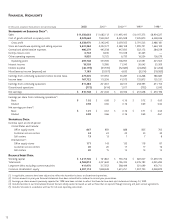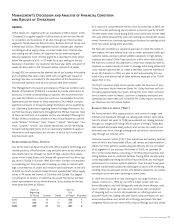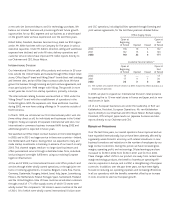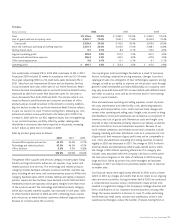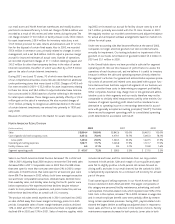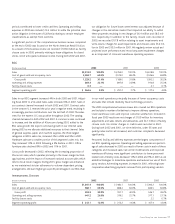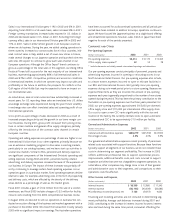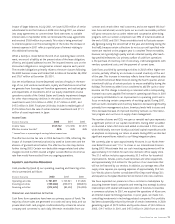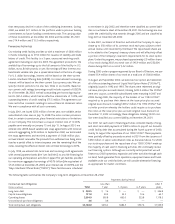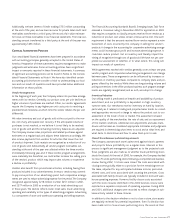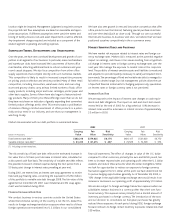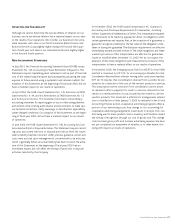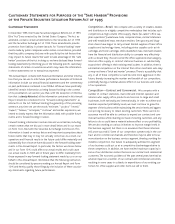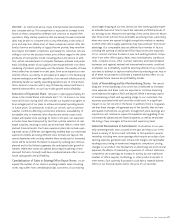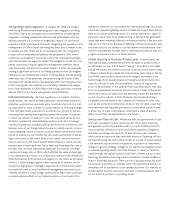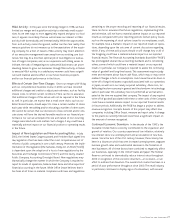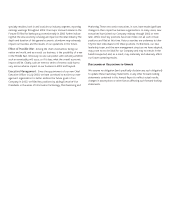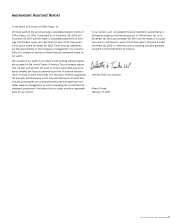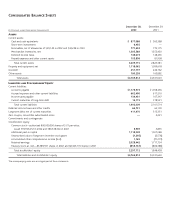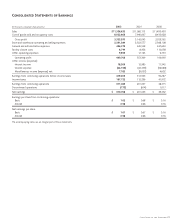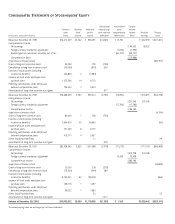Office Depot 2002 Annual Report Download - page 24
Download and view the complete annual report
Please find page 24 of the 2002 Office Depot annual report below. You can navigate through the pages in the report by either clicking on the pages listed below, or by using the keyword search tool below to find specific information within the annual report.
location might be impaired. Management judgment is required to ensure
the projected cash flow assumptions are based on reasonable and appro-
priate assumptions. If different assumptions were used, the extent and
timing of facility closure costs and asset impairments could be affected.
Any impairment charges required are included as a component of the
related segment’s operating and selling expenses.
Significant Trends, Developments and Uncertainties
Over the years, we have seen continued development and growth of com-
petitors in all segments of our business. In particular, mass merchandisers
and warehouse clubs have increased their assortment of home office
merchandise, attracting additional back-to-school customers and year-
round casual shoppers. We also face competition from other office
supply superstores that compete directly with us in numerous markets.
This competition is likely to result in increased competitive pressures
on pricing, product selection and services provided. Many of these retail
competitors, including discounters, warehouse clubs, and even drug
stores and grocery chains, carry at least limited numbers of basic office
supply products, including ink jet and toner cartridges, printer paper and
other basic supplies. Some of them have also begun to feature technol-
ogy products. Many of them price these offerings lower than we do, but
they have not shown an indication of greatly expanding their somewhat
limited product offerings at this time. This trend towards a proliferation
of retailers offering a limited assortment of office products is a poten-
tially serious trend in our industry, and one that our management is
watching closely.
We have also seen growth in new and innovative competitors that offer
office products over the Internet, featuring special purchase incentives
and one-time deals (such as close-outs). Through our own successful
Internet and business-to-business web sites, we believe that we have
positioned ourselves competitively in the e-commerce arena.
Market Sensitive Risks and Positions
We have market risk exposure related to interest rates and foreign cur-
rency exchange rates. Market risk is measured as the potential negative
impact on earnings, cash flows or fair values resulting from a hypotheti-
cal change in interest rates or foreign currency exchange rates over the
next year. We manage the exposure to market risks at the corporate
level. The portfolio of interest-sensitive assets and liabilities is monitored
and adjusted to provide liquidity necessary to satisfy anticipated short-
term needs. The percentage of fixed and variable rate debt is managed to
fall within a desired range. Our risk management policies allow the use
of specified financial instruments for hedging purposes only; speculation
on interest rates or foreign currency rates is not permitted.
Interest Rate Risk
We are exposed to the impact of interest rate changes on cash equiv-
alents and debt obligations. The impact on cash and short-term invest-
ments held at the end of 2002 for a hypothetical 10% decrease in
interest rates would be a decrease in interest income of approximately
$2 million in 2003.
Market risk associated with our debt portfolio is summarized below:
2002 2001
Carrying Fair Risk Carrying Fair Risk
(Dollars in thousands) Value Value Sensitivity Value Value Sensitivity
Fixed interest rate debt(1) $262,213 $279,625 $6,174 $481,107 $531,602 $6,770
Variable interest rate debt(1 ) $ 81,415 $ 81,415 $ 407 $ 74,509 $ 74,509 $ 373
(1) Including current maturities.
The risk sensitivity of fixed rate debt reflects the estimated increase in
fair value from a 50 basis point decrease in interest rates, calculated on
a discounted cash flow basis. The sensitivity of variable rate debt reflects
the possible increase in interest expense during the next period from a
50 basis point change in interest rates prevailing at year-end.
During 2001, we entered into an interest rate swap agreement to receive
fixed and pay floating rates, converting the equivalent of $250 million
of this portfolio to variable rate debt through 2008. The fair value of this
agreement at December 29, 2001 was immaterial and the swap agree-
ment was terminated during 2002.
Foreign Exchange Rate Risk
We conduct business in various countries outside the United States
where the functional currency of the country is not the U.S. dollar. This
results in foreign exchange translation exposure when results of these
foreign operations are translated into U.S. dollars in our consolidated
financial statements. The effect of changes in value of the U.S. dollar
compared to other currencies, primarily the euro and British pound, has
been to increase reported sales and operating profit when the U.S. dollar
weakens and reduce these amounts when the dollar strengthens. While
we look for opportunities to reduce our exposure to foreign currency
fluctuation against the U.S. dollar, at this point we have determined not
to pursue hedging opportunities generally. As of December 28, 2002, a
10% change in the applicable foreign exchange rates would result in an
increase or decrease in our operating profit of approximately $10 million.
We are also subject to foreign exchange transaction exposure when our
subsidiaries transact business in a currency other than their own func-
tional currency. This exposure arises primarily from a limited amount of
inventory purchases in a foreign currency. The introduction of the euro
and our decision to consolidate our European purchases has greatly
reduced these exposures. At each period during 2002, foreign exchange
forward contracts to hedge certain inventory exposures totaled less than
$39 million.


